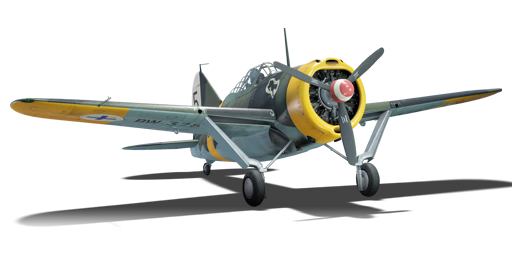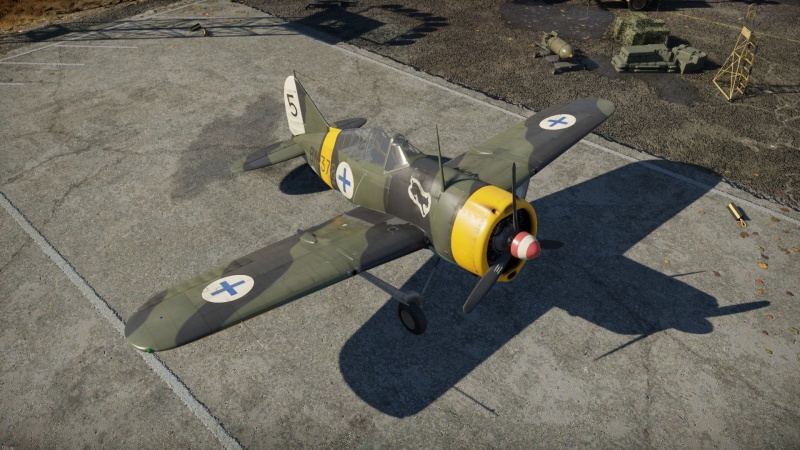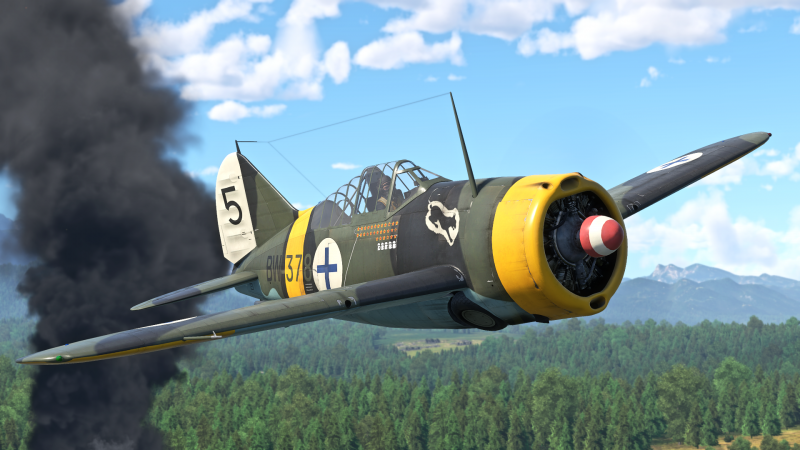B-239 (Sweden)
Contents
Description
The ▄Brewster Model 239 is a denavalized version of the F2A-1 Buffalo, ordered by Finland in 1939 as a means of acquiring a modern fighter plane. Unlike the US Navy F2A-1, the plane had better performance due to being stripped of arresting gear and all other equipment necessary for carrier landings, together with a more powerful Wright R-1820-G5 engine producing 10 hp more compared to the US Navy Buffalos. Another difference was mountings for four machine guns with two in the engine cowling and two in wings. The planes themselves arrived too late to participate in the Winter War, but were used extensively in the Continuation War all the way to late 1944 when they were withdrawn from service. Finnish pilots regarded the plane as very manoeuvrable, easy to fly, and also not requiring extensive maintenance. LeLV 24 had a score of 26:1 using B-239 as they claimed 477 Soviet planes shot down for a loss of just 19 B-239s.
Introduced in Update "Fire and Ice", the B-239 has big potential even in the hands of a not so skilled pilot. Its manoeuvrability and armament compared to contemporaries make it a very dangerous foe. The B-239 is best utilized in a role similar to the Bf 109 as a boom and zoom fighter, although the ability to turnfight not only at high speed is better when compared to the Messerschmitt.
General info
Flight performance
The B-239 is a relatively slow aircraft. With a top speed of only 460 km/h, many other fighters like the Bf 109 E-3 and Yak-1 will be able to outrun or catch the B-239. The B-239’s climb rate is quite average at a climb rate of 14.2 m/s, and with a 9-cylinder radial engine, it also suffers in vertical manoeuvres. Although the B-239 struggles in speed, it can turn extremely well and players will easily be able to outturn many contemporaries and stay competitive with nimble Japanese fighters. It is also very controllable at high speeds even up to its structural rip speed of 761 km/h (475.63 mph).
| Characteristics | Max speed (km/h at 5,400 m) |
Max altitude (metres) |
Turn time (seconds) |
Rate of climb (metres/second) |
Take-off run (metres) | |||
|---|---|---|---|---|---|---|---|---|
| AB | RB | AB | RB | AB | RB | |||
| Stock | 438 | 421 | 9900 | 16.7 | 17.2 | 10.5 | 10.5 | 130 |
| Upgraded | 484 | 460 | 15.8 | 16.0 | 19.1 | 14.2 | ||
Details
| Features | ||||
|---|---|---|---|---|
| Combat flaps | Take-off flaps | Landing flaps | Air brakes | Arrestor gear |
| ✓ | ✓ | ✓ | X | X |
| Limits | ||||||
|---|---|---|---|---|---|---|
| Wings (km/h) | Gear (km/h) | Flaps (km/h) | Max Static G | |||
| Combat | Take-off | Landing | + | - | ||
| 761 | 280 | 425 | 380 | 240 | ~12 | ~4 |
| Optimal velocities (km/h) | |||
|---|---|---|---|
| Ailerons | Rudder | Elevators | Radiator |
| < ~300 | < ~320 | < ~350 | > ___ |
Survivability and armour
- Armour
- 8.5 mm steel - Pilot seat
- Survivability
- Self-sealing wing tanks
- Exposed engine and oil cooling system, prone to damage
Modifications and economy
Armaments
Offensive armament
The B-239 (Sweden) is armed with:
- 2 x 12.7 mm LKk/42 machine guns, nose-mounted (250 rpg = 500 total)
- 2 x 12.7 mm LKk/42 machine guns, wing-mounted (400 rpg = 800 total)
The B-239 has four .50 cals with two mounted in the nose and two mounted in the wings. The guns mounted in the wing have 400 rpg meanwhile the nose-mounted machine guns only have 250 rpg. With a fire rate of 1100 rounds per minute, the nose-mounted MGs will only have around 13.5 seconds of trigger time meanwhile the wing-mounted MGs will last for 21.8 seconds of trigger time. These guns have a much higher fire rate compared to other nations' .50 caliber machine guns so players must be wary of the ammo consumption.
Six different ammunition belts are available to players: default, universal, ground target, air target, tracer, and stealth. For air targets, the best belt, unsurprisingly, is the air target belt due to its belt composition of incendiary rounds with 75% incendiary rounds and 25% AP. The 2nd best belt will be the stealth belt with a composition of 50% incendiary, 50% AP and with the added benefit of enemies being unable to see incoming rounds. Although the B-239 isn’t well suited for ground attack, there are belts for attacking targets like light pillboxes. The ground target and tracer belt are functionally identical in terms of damage. Both belts are fully composed of AP rounds however the ground target belt is 50% AP-T (tracer) and 50% AP meanwhile the tracer belt is full AP-T. The default belt and universal belt are also functionally identical in terms of damage. The main difference between them is that the default belt has a composition of AP-T/AP/I meanwhile the universal belt is AP-T/AP-T/I.
Usage in battles
The B-239 is best used as a fighter although it can be used for ground attacking.
Fighter
The B-239 is a solid fighter for its BR. Although it lacks in some departments like speed, climb rate, and energy retention, it excels in its turning ability and many fighters will be unable to keep up in a turn fight. However, the unfortunate reality of many turn fighters is that faster and overall better-performing planes will be able to dictate the fight. They can choose whether or not they want to fight a B-239. B-239 pilots can try and bring enemy planes down to a lower altitude for teammates but it’s important to not do this with a lot of enemies nearby.
If an enemy plane is bearing down, players must perform a reversal. The best way to conduct a reversal in the B-239 is to enter a shallow dive and throttle down as the enemy plane will gain speed and become less manoeuvrable. Once the enemy plane is within gun range, perform a sharp turn to either side and allow the enemy plane to overshoot. This will allow for a quick window to fire guns if the enemy plane climbs away. If the enemy plane decides to start turning, the fight will be over quickly as there are very few planes that will be able to outturn the B-239. B-239 pilots should also stray away from engaging in vertical fights as they will lose much of their energy and stall out. Horizontal or downward fights are where the B-239 will succeed in.
Sideclimbing is also a valid strategy but it’s important to not overdo it. If done too aggressively, players will be too far from the battlefield to have a significant early-game impact. B-239 pilots can also try and bait enemies down for teammates as well but it will be difficult to score kills with this method.
Countering the Bf 109 F-1
One common enemy for the B-239 is the German Bf 109 F-1. It shares the same battle rating and Sweden regularly faces Germany in Air Realistic Battles. The F-1 is much faster and has a better climb rate than the B-239 however it struggles with turning. B-239 pilots should avoid climbing up toward a 109 F-1. If a B-239 pilot decides to pitch up for an F-1, the F-1 pilot can easily go into a spiral climb and stall out the B-239. The F-1 will always dictate the fight and it’s important to not play its game. B-239 pilots must try and force a turn fight or reverse the F-1 to take it down. Head ons will be a risky option as the F-1 has all of its guns mounted in the nose but has less range compared to the .50 cals on the B-239. Head ons in general shouldn’t be taken so pilots should try and fire from .8 or 1 km (~.6 mi) and then dodge.
Attacker
Firstly, all of the belts will be sufficient in taking out light AA targets like AA or howitzers. If players wish to destroy light pillboxes then either the tracer or ground target belt will be needed. Otherwise, it will take a significant amount of rounds to destroy one light pillbox and the B-239 does not have a large ammo pool. The B-239 has no access to bombs or rockets so medium and heavy tanks are safe from the B-239 in Air Realistic Battles. In Ground Realistic Battles, however, the ground target/tracer belt will be decent in penetrating the engine decks or roofs of many vehicles. The AP rounds can penetrate up to 28 mm of armor which is more than enough for many light tanks and some medium tanks at this BR.
Manual Engine Control
| MEC elements | ||||||
|---|---|---|---|---|---|---|
| Mixer | Pitch | Radiator | Supercharger | Turbocharger | ||
| Oil | Water | Type | ||||
| Controllable | Controllable Not auto controlled |
Not controllable Not auto controlled |
Not controllable Not auto controlled |
Separate | Controllable 2 gears |
Not controllable |
Pros and cons
Pros:
- Very manoeuvrable even at high speeds
- Effective weaponry
- Above average climb rate
Cons:
- Quite slow
- Vital components not protected by armour
- Loses a lot of energy in vertical manoeuvres
- Runs out of ammo quickly
- Weak acceleration
History
At the beginning of 1939, Finland was looking to purchase modern fighter aircraft. They contacted the USA with the only demand being that the plane was already in service and had the ability to use 87-octane fuel. 44 F2A-1 Buffalo fighters intended originally for the US Navy were sold to Finland after the USN agreed to wait for the F2A-2 variant instead. Model B-239E was built with a more powerful Wright R-1820-G5 engine producing 950 hp as opposed to the 940 hp Wright R-1820-34 engine used in USN planes and featured mountings allowing installation of four machine guns instead of two on the American counterpart. The planes were also de-navalised, which meant they weighed less while having better performance.
The planes were delivered in January and February 1940 to Bergen, Norway, then sent by railway to Sweden where they were assembled in SAAB factory at Trollhättan. There, they were equipped with armoured backrests, metric flight instruments, a domestic Väisälä T.h.m.40 gunsight, and four 12.7 mm machine guns. Unimpressed with the plane at first, the Finnish view on it changed drastically after a Brewster company test pilot demonstrated that the B-239E was able to out-turn the Fiat G.50 Freccia fighter, although it was slower in level flight than the G.50. None of the B-239s saw combat during the Winter War.
Finnish pilots regarded the B-239 as an easy to fly plane, while its relatively long range and easy maintenance allowed to keep them operational without much effort. It earned a reputation as one of the best Finnish fighters alongside the Fiat G.50 which had a kill-loss ratio of 33:1, while Lentolaivue 24 (Fighter Squadron 24) managed to score 26:1 ratio with 477 Soviet planes claimed destroyed with loss of only 19 B-239s. Finnish B-239s were in service from 1940 all the way to 1948 with the last eight remaining since the end of war in Lapland. The last victory of a B-239 over Soviet aircraft was claimed on 17th June 1944 near the Karelian Isthmus, while the last victory of a B-239 in WWII was achieved on 3rd October 1944 when HLeLV 26 intercepted German Ju-87 Stuka dive bombers and claimed two shot down.
Media
- Skins
See also
- Related development
External links
Paste links to sources and external resources, such as:
- topic on the official game forum;
- other literature.
| Brewster Aeronautical Corporation | |
|---|---|
| Fighters | F2A-1 · Thach's F2A-1 · F2A-3 |
| Export | ▄B-239 |
| Sweden fighters | |
|---|---|
| ASJA | J6B |
| Saab | J21A-1 · J21A-2 · A21A-3 |
| FFVS | J22-A · J22-B |
| Foreign Import | J8A · Iacobi's J8A · J9 Early · J11 · J20 · J26 David · J26 |
| Finland | |
| VL | Mörkö-Morane · VL Myrsky II · VL Pyörremyrsky |
| (NL) Fokker | ▄Fokker D.XXI-3 · ▄Fokker D.XXI |
| (DE) Messerschmitt | ▄Bf 109 G-2 · ▄Bf 109 G-6 Erla · ▄Bf 109 G-6 |
| Other | ▄B-239 · ▄Hurricane Mk I/L |






